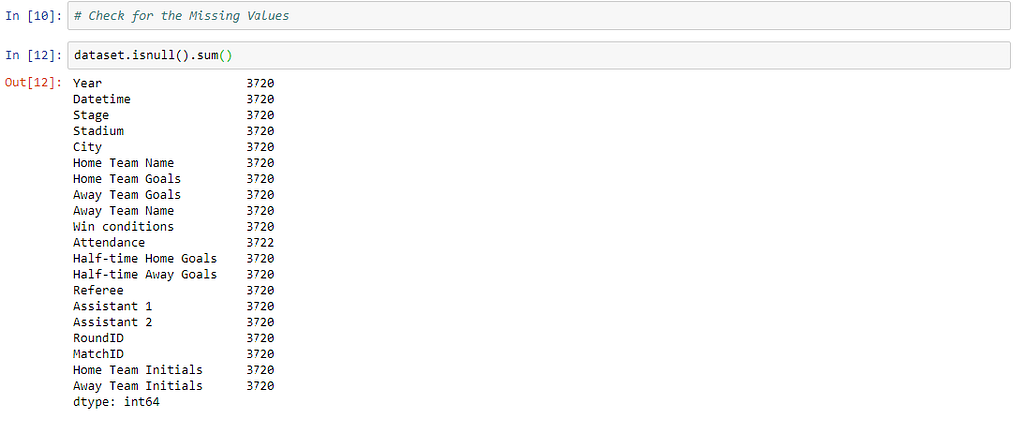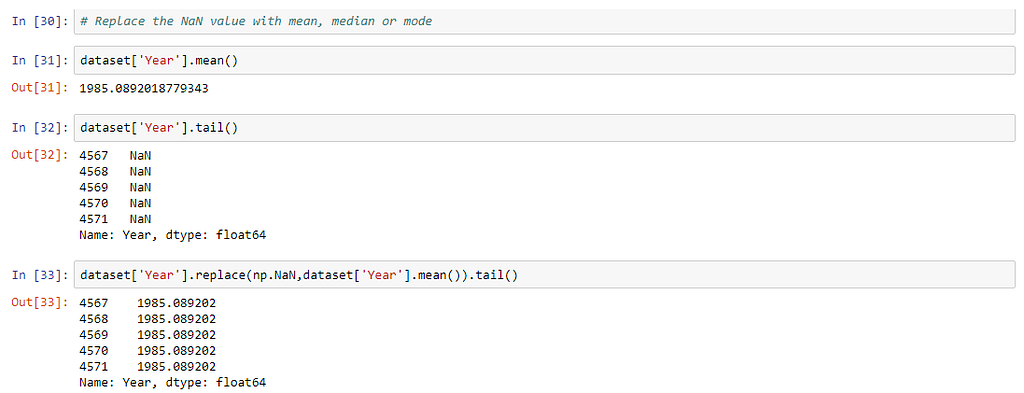Latest news about Bitcoin and all cryptocurrencies. Your daily crypto news habit.
Hello everyone, I am back with another topic which is Data Preprocessing.
What is Data Preprocessing ?
Data preprocessing is a data mining technique that involves transforming raw data into an understandable format. Real-world data is often incomplete, inconsistent, and/or lacking in certain behaviors or trends, and is likely to contain many errors. Data preprocessing is a proven method of resolving such issues.
Why we use Data Preprocessing ?
In Real world data are generally incomplete: lacking attribute values, lacking certain attributes of interest, or containing only aggregate data. Noisy: containing errors or outliers. Inconsistent: containing discrepancies in codes or names.
 Taken from Google Images
Taken from Google Images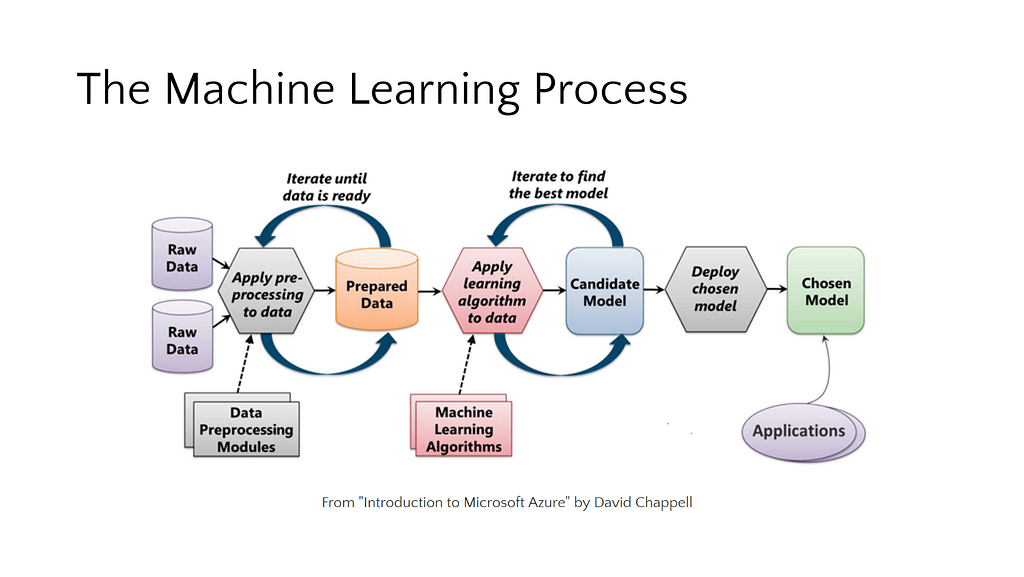 Machine Learning Process
Machine Learning Process
Steps in Data Preprocessing
Step 1 : Import the libraries
Step 2 : Import the data-set
Step 3 : Check out the missing values
Step 4 : See the Categorical Values
Step 5 : Splitting the data-set into Training and Test Set
Step 6 : Feature Scaling
So, without wasting further time let’s get started!!!
“ New beginnings often starts with painful endings. Be thankful for those closed doors and detours, they are guiding you to a better place”
Step 1 : Import the Libraries Import the Libraries
Import the Libraries
This is how we import libraries in Python using import keyword and this is the most popular libraries which any Data Scientist used. (I used- Jupyter Notebook)
- NumPy is the fundamental package for scientific computing with Python. It contains among other things:
1. A powerful N-dimensional array object
2. Sophisticated (broadcasting) functions
3. Tools for integrating C/C++ and FORTRAN code
4. Useful linear algebra, Fourier transform, and random number capabilities
- Pandas is for data manipulation and analysis. Pandas is an open source, BSD-licensed library providing high-performance, easy-to-use data structures and data analysis tools for the Python programming language. Pandas is a NumFOCUS sponsored project. This will help ensure the success of development of pandas as a world-class open-source project, and makes it possible to donate to the project.
- Matplotlib is a Python 2D plotting library which produces publication quality figures in a variety of hard copy formats and interactive environments across platforms. Matplotlib can be used in Python scripts, the Python and IPython shells, the Jupyter notebook, web application servers, and four graphical user interface toolkits.
- Seaborn is a Python data visualization library based on matplotlib. It provides a high-level interface for drawing attractive and informative statistical graphics.
- Warning messages are typically issued in situations where it is useful to alert the user of some condition in a program, where that condition (normally) doesn’t warrant raising an exception and terminating the program. For example, one might want to issue a warning when a program uses an obsolete module.
Step 2 : Import the Data-set Import the Dataset
Import the Dataset Dataset Info
Dataset Info
By using Pandas we import our data-set and the file I used here is .csv file [Note: It’s not necessarily every-time you deal with CSV file, sometimes you deal with Html or Xlsx(Excel file) ]. However, to access and to use fastly we use CSV files because of their light weights. After importing the dataset, you can see we use head function ( This function returns the first n rows for the object based on position. It is useful for quickly testing if your object has the right type of data in it. By default it returns 5 rows. )
Step 3 : Check out the Missing Values
The concept of missing values is important to understand in order to successfully manage data. If the missing values are not handled properly by the researcher, then he/she may end up drawing an inaccurate inference about the data. Due to improper handling, the result obtained by the researcher will differ from ones where the missing values are present.
Yes, you have seen it write this number 3720 is your missing values in each column.
May be or May not you have read somewhere, see 7 techniques to deal with Missing Values or 5 ways to deal with Missing Values. But, I will discuss with you only those two ways which are the most prominent.
Two ways to handle Missing Values
- This method commonly used to handle the null values. Here, we either delete a particular row if it has a null value for a particular feature and a particular column if it has more than 75% of missing values. This method is advised only when there are enough samples in the data set. One has to make sure that after we have deleted the data, there is no addition of bias. Removing the data will lead to loss of information which will not give the expected results while predicting the output.
2. This strategy can be applied on a feature which has numeric data like the year column or Home team goal column. We can calculate the mean, median or mode of the feature and replace it with the missing values. This is an approximation which can add variance to the data set. But the loss of the data can be negated by this method which yields better results compared to removal of rows and columns. Replacing with the above three approximations are a statistical approach of handling the missing values. This method is also called as leaking the data while training. Another way is to approximate it with the deviation of neighbouring values. This works better if the data is linear.
Above strategy is good for numeric data. But what happen when Categorical data has missing values?
Step 4 : See the Categorical Values
Let’s see how to deal with Categorical Data now . . . !
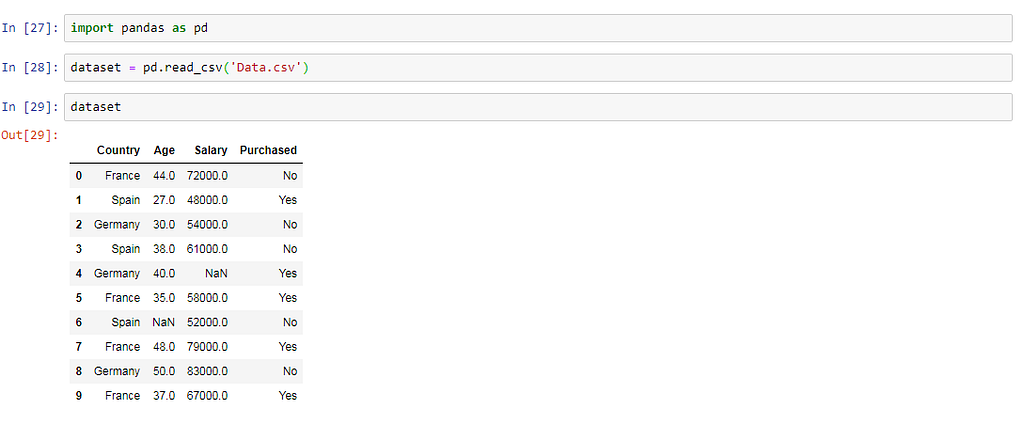 See the Categorical Data in CountrySince, machine learning models are based on Mathematical equations and you can intuitively understand that it would cause some problem if we can keep the Categorical data in the equations because we would only want numbers in the equations.
See the Categorical Data in CountrySince, machine learning models are based on Mathematical equations and you can intuitively understand that it would cause some problem if we can keep the Categorical data in the equations because we would only want numbers in the equations.
So, we need to encode the Categorical Variable…..
Like in our data set Country column will cause problem, so will convert into numerical values. To convert Categorical variable into Numerical data we can use LabelEncoder() class from preprocessing library.
 See the Categorical data
See the Categorical data Use LabelEncoder class to convert Categorical data into numerical one
Use LabelEncoder class to convert Categorical data into numerical one
label_encoder is object which is I use and help us in transferring Categorical data into Numerical data. Next, I fitted this label_encoder object to the first column of our matrix X and all this return the first column country of the matrix X encoded.
But there is a problem in it, the problem is still the same, machine learning models are based on equations and that’s good that we replaced the text by numbers so that we can include the numbers in the equations.
However, since 1>0 and 2>1(See the above data-set) , the equations in the model will think that Spain has a higher value than Germany and France, and Germany has a higher value than France.
Actually, this is a not the case, these are actually three Categories and there is no relational order between the three. So , we have to prevent this, we’re going to use what are Dummy Variables.
What is Dummy Variables ?
Dummy Variables is one that takes the value 0 or 1 to indicate the absence or presence of some categorical effect that may be expected to shift the outcome.
Instead of having one column here above, we are going to have three column.
Number of Columns = Number of Categories
In our case we going to have 3 columns.
// To create dummy variable we are going to use OneHotEncoder Class from sklearn.preprocessing or you can use pandas get dummies method.
In above code, I already explain how to use OneHotEnCoder Class, now I will show you with pandas how to use get_dummies( ) for creating Dummy Variables.
 Using Pandas to create Dummy Variables
Using Pandas to create Dummy Variables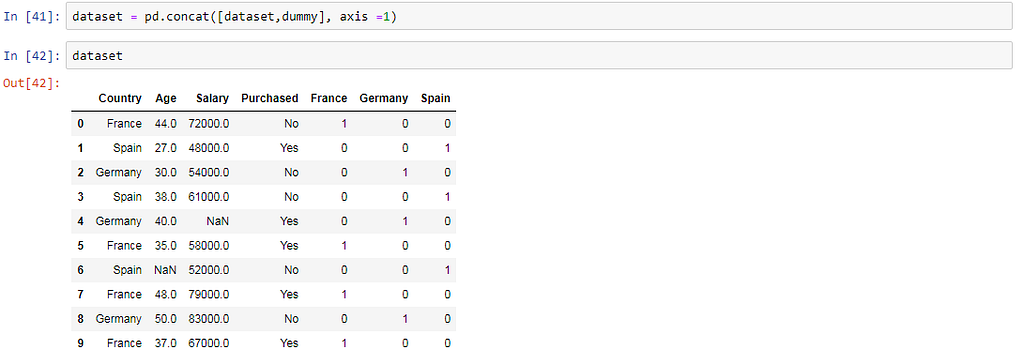 Concatenation
Concatenation See how our Dataset looks like
See how our Dataset looks like
Sometimes, we use KNN Imputation(for Categorical variables): In this method of imputation, the missing values of an attribute are imputed using the given number of attributes that are most similar to the attribute whose values are missing. The similarity of two attributes is determined using a distance function.
Step 5 : Splitting the data-set into Training and Test Set
In any Machine Learning model is that we’re going to split data-set into two separate sets
1. Training Set
2. Test Set
Why we need splitting ?
Well here it’s your algorithm model that is going to learn from your data to make predictions. Generally we split the data-set into 70:30 ratio or 80:20 what does it mean, 70 percent data take in train and 30 percent data take in test. However, this Splitting can be varies according to the data-set shape and size.
 Splitting the Data-set into two set — Train and Test SetX_train is the training part of the matrix of features.X_test is the test part of the matrix of features.y_train is the training part of the dependent variable that is associated to X_train here.y_test is the test part of the dependent variable that is associated to X_train here.Step 6 : Feature Scaling
Splitting the Data-set into two set — Train and Test SetX_train is the training part of the matrix of features.X_test is the test part of the matrix of features.y_train is the training part of the dependent variable that is associated to X_train here.y_test is the test part of the dependent variable that is associated to X_train here.Step 6 : Feature Scaling
What is Feature Scaling ?
Feature scaling is the method to limit the range of variables so that they can be compared on common grounds.
Suppose we have this data-set
See the Age and Salary column. You can easily noticed Salary and Age variable don’t have the same scale and this will cause some issue in your machine learning model.
Because most of the Machine Learning models are based on Euclidean Distance.
Let’s say we take two values from Age and Salary column
Age- 40 and 27
Salary- 72000 and 48000
One can easily compute and see that Salary column will be dominated in Euclidean Distance. And we don’t want this thing.
So, there are several ways of scaling your data. Reference
 Picture taken from Wikipedia
Picture taken from Wikipedia Feature Scaling
Feature Scaling After Feature Scaling all values comes into same scale
After Feature Scaling all values comes into same scale
Note: Sometimes machine models are not based on Euclidean distances, we will still need to do features scaling because the algorithm will converge much faster. That will be the case for Decision Tree which are not based on ED but, if we do not do feature scaling then they will run a very long time.
So that’s our end with Data Preprocessing phase and I hope you like this Article . . . !! Please note I have not included outliers topic in it and taken very simple data-set to make you understand everything. Please feel free to comment and give some applaud on it. If you have any problem or query in any topic related to Data Science then do let me know in the comment Section. I’ll share more concepts soon on LinkedIn.com Article column as well as Medium.
Give some love too!
Mohit Sharma(themenyouwanttobe&Co.)themenyouwanttobe@gmail.com/ Telegram
What Steps should one take while doing Data Preprocessing? was originally published in Hacker Noon on Medium, where people are continuing the conversation by highlighting and responding to this story.
Disclaimer
The views and opinions expressed in this article are solely those of the authors and do not reflect the views of Bitcoin Insider. Every investment and trading move involves risk - this is especially true for cryptocurrencies given their volatility. We strongly advise our readers to conduct their own research when making a decision.
